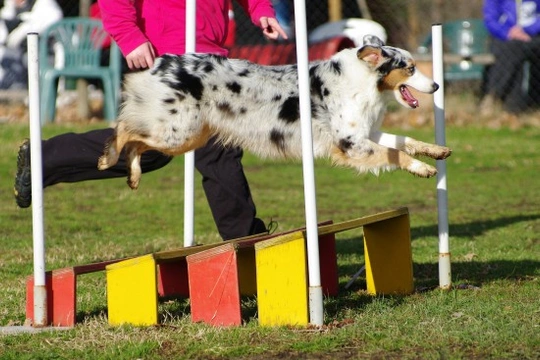
Working trials - Canine competition
Working Trials are canine competitions based on the civilian equivalents of the skills that police dogs learn and utilise as part of their working roles. The trials are developed to teach and test a wide range of skills to dogs, including agility, physical fitness, tracking and searching, intelligence, problem solving, independence and obedience.
Working trials are excellent fun for both dog and handler, but they are also very physically demanding on both parties as well, and require excellent fitness levels! Working trial competitions are organised or licensed by The Kennel Club, the governing body that oversees many different canine sports and disciplines as well as providing breed registration.
The different sections of working trials competitions
Working trials competitions are broken down into three sections: Nosework, agility and control.
Nosework
Nosework consists of tracking and seeking exercises, and the tracking part is undertaken over a course around half a mile long. A tracklayer will walk the course and lay out articles for the dog to find, and the dog then has to follow the course and recover the objects. In the second section of the competition, the dog has to seek and retrieve objects left within a set area.
Agility
In the agility section of the competition, the dog is given two attempts to clear three different obstacles, such as a hurdle, a balancing scale and a long jump.
Control
Dogs must demonstrate six different skills as part of control:
- Heelwork, walking appropriately to heel and keeping pace with the handler while the handler moves around people and obstacles at varying speeds.
- Sendaway, where the handler instructs the dog to leave the handler and retreat to a minimum distance of 50 yards, and the handler will then issue commands to the dog that the dog must follow.
- Retrieving, where the dog must collect and retrieve a dumbbell thrown by the handler.
- Stay down, where the handler instructs the dog to lay down and stay there while the handler leaves the dog’s sight.
- Gun reaction involves testing the dog’s reactions to gunshots, and the dog should take the sound in its stride, and not show any fear or aggression in reaction to the noise.
- “Speak” involves the dog successfully following the command to bark on demand, and to continue to bark until instructed to stop, and then stopping promptly.
Can my dog compete in working trials?
There are no breed-specific restrictions on getting involved in working trials training, and theoretically, any type of dog can compete if they have the right skills! In reality, the build and intelligence of the dog will largely dictate their suitability for the sport, and fit medium weight dogs with superior intelligence are the type that do best at the sport and will prove themselves viable to compete. Both purebred and mixed breed dogs can compete in working trials on an equal footing, and while you will usually see a fair amount of Border Collies, German Shepherd dogs and Springer Spaniels in competitions, you will also see plenty of mixed-breed dogs too.
Training and getting started
Training and preparing for working dog trials is usually done in clubs and teams, as individual dog owners are unlikely to have access to the type of equipment required to practice with. Clubs and groups usually welcome new members at all times of the year and actively encourage dog owners to have a go, but before you go to a meet or join a club to work on your skills, you should reach a basic level of competence with your own dog first. Ensure that your dog is fit and healthy, alert and interested in undertaking tasks, and will follow your commands and try their best to learn new skills- then you are ready to go along to a club meet as a novice.
Formal requirements for competition entrants
- In order to compete in actual organised working trial events, your dog must be registered with The Kennel Club beforehand. Either registration on the breed registry or the activity registry is acceptable.
- The dog must be aged over 18 months old by the date that applications for the competition close; this distinction is important, as other styles of competition usually state the 18 month rule for the day of the competition itself.
- You must fill in an entry form and submit it to the trial’s organisers in advance of the closing date for applications, which is usually six weeks or more before the trial itself, in order to give dog handlers plenty of time to prepare for the competition.
- You must be familiar with the rules and regulations associated with the event, and this information is available directly from The Kennel Club, but experienced handlers in the club that you attend will usually be able to advise you too.



